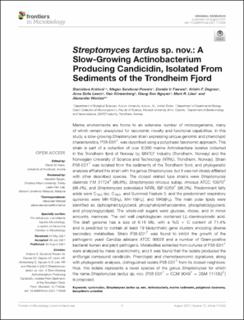| dc.description.abstract | Marine environments are home to an extensive number of microorganisms, many of which remain unexplored for taxonomic novelty and functional capabilities. In this study, a slow-growing Streptomyces strain expressing unique genomic and phenotypic characteristics, P38-E01T , was described using a polyphasic taxonomic approach. This strain is part of a collection of over 8,000 marine Actinobacteria isolates collected in the Trondheim fjord of Norway by SINTEF Industry (Trondheim, Norway) and the Norwegian University of Science and Technology (NTNU, Trondheim, Norway). Strain P38-E01T was isolated from the sediments of the Trondheim fjord, and phylogenetic analyses affiliated this strain with the genus Streptomyces, but it was not closely affiliated with other described species. The closest related type strains were Streptomyces daliensis YIM 31724T (98.6%), Streptomyces rimosus subsp. rimosus ATCC 10970T (98.4%), and Streptomyces sclerotialus NRRL ISP-5269T (98.3%). Predominant fatty acids were C16V0 iso, C16V0, and Summed Feature 3, and the predominant respiratory quinones were MK-10(H6), MK-10(H4), and MK9(H4). The main polar lipids were identified as diphosphatidylglycerol, phosphatidylethanolamine, hosphatidylglycerol, and phosphoglycolipid. The whole-cell sugars were glucose, ribose, and in minor amounts, mannose. The cell wall peptidoglycan contained LL-diaminopimelic acid. The draft genome has a size of 6.16 Mb, with a %G C C content of 71.4% and is predicted to contain at least 19 biosynthetic gene clusters encoding diverse secondary metabolites. Strain P38-E01T was found to inhibit the growth of the pathogenic yeast Candida albicans ATCC 90028 and a number of Gram-positive bacterial human and plant pathogens. Metabolites extracted from cultures of P38-E01T were analyzed by mass spectrometry, and it was found that the isolate produced the antifungal compound candicidin. Phenotypic and chemotaxonomic signatures, along with phylogenetic analyses, distinguished isolate P38-E01T from its closest neighbors; thus, this isolate represents a novel species of the genus Streptomyces for which the name Streptomyces tardus sp. nov. (P38-E01T D CCM 9049T D DSM 111582T ) is proposed. | en_US |

